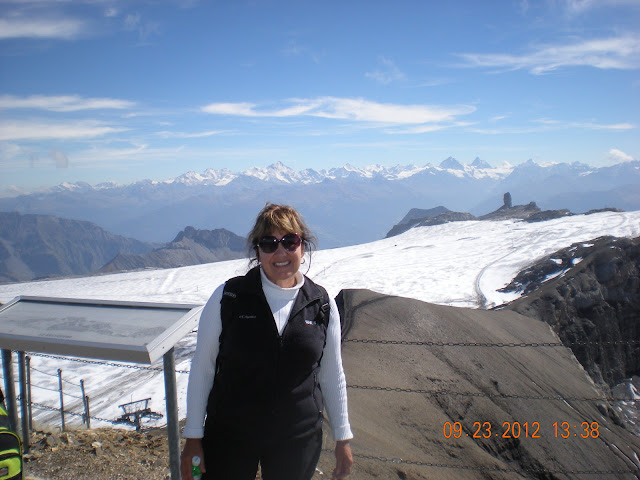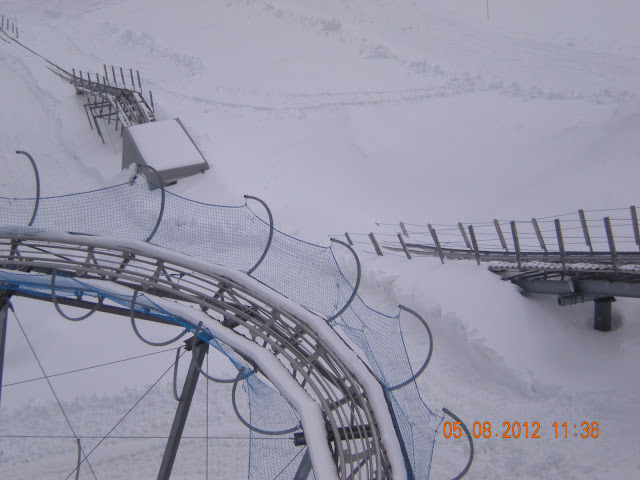So, a group of us from Nestle made the trip on Sunday, Sept. 23rd. The trip took about 1 3/4 hours, by train and bus, to reach the lift that would take us to the top of the mountain
On the way you can see the foliage is starting to change, winter won't be long in coming.
The ever present Swiss cows.
We finally reached Col du Pillon. This is where we caught the cable car that took us to the top of the mountain.
A view of the mountains and valleys from the cable car.
Paula and Ash, one of our Nestle friends, in the cable car. Ash will be leaving her assignment in Switzerland in early October and will head back to the Glendale, CA. to continue her Nestle career.
There are two cable car stations required to make the trip to the top. This is the second one.
Approaching Glacier 3000.
Once we reached Glacier 3000, we decided to eat lunch before riding the Alpine Coaster. Pictured from left is Roman, Laura, Juan (he works for Nestle), Nick and Karissa.
Also enjoying lunch is Susan, Paula and Dan (he works for Nestle).
The third group enjoying lunch is John, Ash and Jodie (they all work for Nestle).
After we finished lunch we decided to walk up to the highest point on the mountain. Pictured from left to right in the front row: Jodie, Susan, Ash, Laura, Nick, Karissa and Paula. Back row from left to right: Dan, Roman, Juan and John. The views of the surrounding mountains were just awesome.
Paula on the very top of the mountain with the Alps in the back ground.
Now, what we have all been waiting for, the Alpine Coaster ride. Glacier 3000 is so named because it is situated at an elevation of 3000 meters.
Constructed in 2007, at an altitude of 3,000 m, (9,842 ft), the Alpine Coaster is the highest rail sled installation worldwide. Some thirty sleds tear down the slope, 20 ft above ground, opposite a breathtaking panorama of twenty-four Alpine peaks that are over 13,000 ft high. Sledders are in charge of their own speed, reaching peaks of 25 mph in a breathtaking descent. The descent over ten curves (one at 520°) jumps and bridges takes a mere two minutes. However, if you use the brakes a lot it will certainly take much longer.
A partial view of the track.
Another view of the track.
The next six pictures shows the condition of the track on May 8, 2012.
The next few photos are of some of our group as they start their run down the slide. Paula starting her run.
I want to thank John for these pictures as I was riding in a sled and could not take any pictures.
In the front sled are Nick and Roman. In the second sled are Karissa and Juan.
Nick and Roman.
Karissa and Juan.
Hanna and Tim.
Susan and Dan.
After we all had two or three rides each, on the Alpine Coaster, we decided to hike out on to the glacier.
Paula, on the chair lift, that took us to the beginning of the glacier.
Tim and Hanna on the glacier.
Paula and Hanna on the glacier.
Our group walking on the glacier.
A view of one of the small crevices on the glacier.
As we were walking on the glacier, one of the men who works at Glacier 3000, told us that they had just rescued a man who had fallen into a crevice. It took them over 40 minutes to get him out. He told us where to walk so that we would be safe.
As we walked on the glacier, you could hear the water running just under the surface of the glacier, a really neat experience.
Our day of fun ended, we took this little train back to Aigle, so we could catch the big train back to Vevey.
Aigle Castle.
Aigle is a small town of around 10,000 people located 15 miles southeast of Vevey.
The Barons of Aigle were first mentioned in
1179. At that time they had a small fortification, that became the center of
the modern castle.
Some time before 1200, the Barons of Aigle
ended up as vassals of the powerful Counts of Savoy. In 1232, Count Thomas of Savoy granted
Aigle as a fiefdom to the brothers Jacob and Peter of Saillon, in
exchange for their ancestral castle in Valais, which is located in southwestern
Switzerland. The Saillon family
seems to have been closely related with the barons of Aigle.
In the second half of the 13th Century, the
castle was rebuilt, with a fortified keep (a type of fortified tower
built within castles during the Middle Ages) and a wall surrounding
the castle.
In the 14th Century, the Lords of Compey
inherited the rights of the Saillon family. They were also vassals of the
Counts of Savoy and made Aigle into their headquarters. They added turrets and
in 1450 built a massive tower in the south corner.
Starting in the mid-15th Century, Bern tried to
control the city, to gain control of the important mountain passes into the
Rhone Valley. Their first unsuccessful attempt was in 1464. The Burgundian Wars (1474–1477), which
brought the Swiss Confederation into conflict with Duke Charles the Bold of
Burgundy, brought another opportunity. Because Savoy had
joined the Burgundian side, Swiss forces attacked the Savoy town of Aigle and
devastated the castle. Jean de
Compey had to flee and was killed soon afterward in Vevey. His son died
fighting for Charles the Bold.
After the war, the Compey family was unable to
recover their title to the town or castle. Bern had the castle rebuilt again in
1488 and made it the seat of a provincial governor. Aigle became one of the
first French speaking districts in Bern. The representatives of Bern resided
here until the French invasion and creation of the Swiss Republic in 1798.
In 1804, the community of Aigle acquired the
castle and until 1976 it was used as a jail. Since then, it has been a museum
open to the public.






































No comments:
Post a Comment